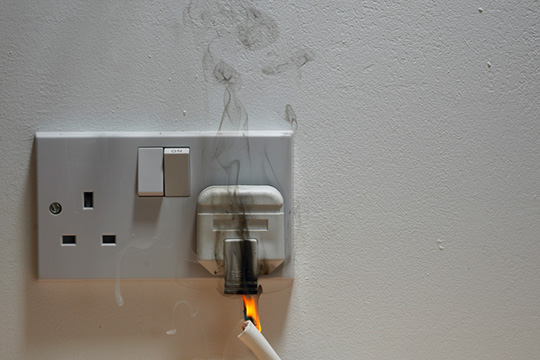Most homeowners know that overloading circuits and using frayed extension cords can lead to electrical fires. But there are other electrical fire dangers in your home that may not be as obvious but are no less dangerous.
Electrical failure or malfunction caused an estimated 52,500 fires in U.S. homes in 2006, resulting in 340 deaths, 1,400 injuries, and nearly $1.5 billion in property damage, according to the National Fire Protection Association.
Electrical Home Safety Warning Signs
You may not know about the warning signs of these four potential hazards. If any of them sound familiar, consider hiring a licensed electrician to conduct a wiring inspection ($200 to $300).
Hidden Danger #1: Old Wiring
The lifespan of an electrical system is 30 to 40 years. But more than 30% of the nation’s houses — some 30 million homes — are more than 50 years old. “Older homes with fuses were set up for about 30 amps of power; many homes now have 100, 150, even 200 amps of power,” says John Drengenberg, consumer safety director for Underwriters Laboratories, which conducted a study of aging residential wiring.
Warning signs of inadequate power include circuit breakers that trip or fuses that blow repeatedly, and an overreliance on extension cords. “They’re meant to be temporary,” Drengenberg says. “If you have extension cords routed all over, it’s time to get an electrician out there. Your home would not comply with the National Electrical Code.”
Hidden Danger #2: Aluminum Wiring
Many houses built in the 1960s and early 1970s have aluminum wiring, which oxidizes and corrodes more easily than copper. The Consumer Product Safety Commission has linked aluminum wiring to electrical fires. “It’s OK for a while, but it doesn’t have the life that copper does, particularly where wires terminate. The terminals and splices are known for overheating,” says Roger L. Boyell, a forensic engineer in Moorestown, N.J.
Short of a whole-house wiring upgrade, an electrician may be able to head off potential problems by installing copper connectors, called pigtails, at receptacles and breakers. “It’s time-consuming,” Boyell says, “but there’s no big equipment involved.”
Related: When It’s Time for an Electrical Wiring Upgrade
Hidden Danger #3: Arc Faults
An arc fault — which occurs when electrical current veers off its intended path, often through a breach in wiring — is a leading cause of electrical fires, according to the National Fire Protection Association. It doesn’t take much to cause an arc fault. You could damage wiring inside the wall when hanging a cabinet, a piece of furniture could cut through a cord, or an outlet may have a loose connection.
The resulting arc, capable of producing heat in excess of 10,000 degrees Fahrenheit, can be nearly impossible to detect. But arc faults are preventable. A device called an arc-fault circuit interrupter (AFCI) senses these dangerous abnormalities in wiring or appliances and shuts down the circuit before it overheats. The Electrical Safety Foundation International estimates that the use of AFCIs could prevent 50% to 75% of fires caused by arc faults.
AFCIs are now required on circuits covering most general living areas in new houses. (Note: These are not the same as ground-fault circuit interrupters, or GFCIs, which are used in kitchens, baths, and other wet areas to prevent electrical shocks.) But they’re even more valuable in older houses, where connections may have degraded over the years. It’s an easy job for an electrician to upgrade standard circuit breakers, which don’t protect against arc faults, to AFCIs. At $30 to $50 per breaker, it could cost a few hundred dollars to retrofit every circuit. Still, weighed against the potential tragedy of a house fire, it’s money well spent.
Hidden Danger #4: Counterfeit Electrical Products
If you’ve ever gone to a flea market and seen vendors hawking extension cords, power strips, night lights, batteries, even circuit breakers for ridiculously low prices, there’s a reason. They’re probably counterfeits, and they’re incredibly dangerous. “I’ve seen extension cords all over the country that have inferior copper in them. It’s speaker wire, and it literally melts in your hands,” says Brett Brenner, president of the Electrical Safety Foundation International. “They’re putting a lot of people at risk.”
Your best bet is to buy electrical products only from reputable retailers who will take them back if they don’t work. And look for the Underwriters Laboratories seal. On low-cost items that are ripe for counterfeits, UL puts its logo in a holographic label that’s much more difficult to reproduce.
If the Worst Happens: Extinguishing an Electrical Fire
Electrical fires are tricky to put out. If you douse them with water, you run the risk of electrocution, and not all chemical fire suppressants will extinguish them completely. To be safe, make sure your household fire extinguisher is rated A-B-C, which indicates that it’s effective against fires involving ordinary combustible materials, flammable liquids, and electrical equipment.
